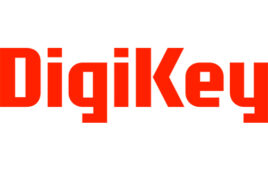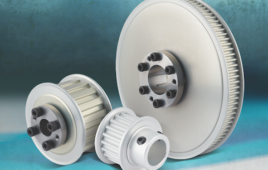
The Hyphen Makeline delivers a modular, industrial-hardened solution to help restaurants put kitchen operations on autopilot. Image: Beckhoff Automation.
Now an industrial-appliance-sized design called the Makeline from food services company Hyphen is leveraging software, rugged automation, and networked controls to help labor-strapped restaurants meet modern business demands.
“We founded the business in July 2018 to leverage automation technology in modern restaurants,” said Daniel Fukuba, Co-Founder and CTO of Hyphen. “Shortly thereafter, we built the first completely automated food truck. During the COVID-19 pandemic, we pivoted and designed our new Makeline system to give restaurants the infrastructure to adapt toward digital-first ordering.”
The Hyphen Makeline assembles salads, and other menu items served in a bowl — handling hundreds of ingredients at various temperatures. The system connects to Hyphen’s cloud services to route digital orders via MQTT. After receiving an order, the Makeline activates dispensers to fill the bowls, conveying them through connected modules inside the enclosure. The machine also controls food safety and provides data insights about peak ordering times and customer habits. From the outside, it looks like a traditional makeline, and restaurant staff can still load ingredients and manually serve those who prefer to order in person.

A C6030 ultra-compact IPC serves as both machine controller and IoT gateway for the Makeline. PC-based automation and EtherCAT technologies from Beckhoff help the new system from Hyphen make 350 meals per hour with 99% order accuracy. Image: Beckhoff Automation.
Clean control architecture eliminates messy situations
Hyphen wanted the Makeline to fit into existing restaurant facilities; as Fukuba explained, “You can already buy mature industrial equipment off the shelf to process 300,000 pounds of salad per day. On the other end of the continuum, there are vending machines with prepackaged goods. In between, there’s no automation to handle the capacities and product variety for restaurant-based food service.” That’s partly because it’s technologically difficult to cram the necessary capabilities into a form factor small enough for standard kitchens.
The Makeline must fit more than 70 actuators plus the cloud-connected controls and I/O into what is essentially a restaurant-grade kitchen appliance. In addition to minimizing footprint, the system needed to meet hygienic standards, and Hyphen also required process controls, time and temperature holding information, and the ability to audit and log the food storage environment. The machines would need to accommodate 500 different ingredients, which all interact differently depending on the menu item.
In early 2020, the Hyphen controls engineering team started to explore EtherCAT and PC-based control technologies from Beckhoff Automation. “The Makeline’s requirements called for vendor agnostic, easy-to-interface systems,” said Bradley Hwang, Controls Engineer at Hyphen. “Beckhoff simplified seamless communication from the PLC runtime up to the cloud so the software team could develop a completely new layer between that and third-party services.” Hyphen engineers and the Beckhoff sales and application engineering team at the nearby Silicon Valley Technical Center collaborated to create a solution.

The EJ series I/O Terminals allow Hyphen to implement TwinSAFE functional safety in a pluggable, space-saving form factor. Image: Beckhoff Automation.
EtherCAT and I/O: more than a slice
The EtherCAT industrial Ethernet system proved indispensable for Hyphen. The speed and modularity of EtherCAT helped optimize system communication, and the network doesn’t need switches, which reduced cost and space requirements. Each Makeline module features pluggable EJ series EtherCAT I/O technology for functional safety, which mount to a custom-design PCB board. These pluggable TwinSAFE terminals are roughly 50% smaller than traditionally wired I/O slices and reduce potential wiring errors.
“Most industrial electrical cabinets with this amount of I/O are massive, but that wasn’t an option for this product. With the EJ safety modules, we could connectorize communication, power supply, and more on a space-saving circuit board, allowing easy and repeatable assembly,” Hwang explained.
Using TwinSAFE technology from Beckhoff lets engineers apply safety devices for doors and potential hazards in a simple programmable way sans hardwiring needed by traditional safety systems. TwinSAFE uses the Safety over EtherCAT (FSoE) protocol to communicate via a black-channel approach.
Control software and hardware serve up performance
TwinCAT three automation software provided a comprehensive engineering and runtime platform for the Makeline. TwinCAT supports many programming methods. This made it easier for Hyphen to bridge the gap between its controls and app-development technologies. “We want to be able to scale the Makeline from 10 units to 10,000 without having to scale the workforce proportionally,” Hwang said. “TwinCAT allows us to use Structured Text, collaborate with version control, and leverage software-oriented processes like GitHub.”
The Makeline relies on one C6030 Industrial PC (IPC) for all operations. TwinCAT offers core-isolation capabilities to enhance system performance by designating individual processes in the quad-core CPU, such as PLC or IoT, to one specific core in the IPC. The C6030 is suitable as an IoT gateway and machine controller.

EtherCAT networking and hardware deliver fast cycle times with minimal footprints. Image: Beckhoff Automation.
The C6030 resides in a base cell with a CP3924 multi-touch Control Panel. The 24-in. pole-mounted display provides a user interface for the environment, according to Fukuba: “We develop the HMI screens like modern web apps, so the multi-touch capabilities and display fidelity give us the responsiveness that we want in the UI. This user-friendliness means any restaurant employee can operate the Makeline.”
A recipe for disruption
Hyphen began conceptualizing the Makeline in mid-2020, and its first units will arrive at design engineers by the end of 2021. The machines can produce 350 meals per hour with 99% accuracy, and it improves portioning precision from the industry average of +/-15% down to +/-2%.
The control hardware, IoT, and networking technologies from Beckhoff helped Hyphen deliver the technical capabilities while meeting footprint requirements. The engineering team plans to continue working with Beckhoff sales and support to add more automation technologies in the future and is already testing TwinCAT Vision as a solution for greater quality control and inspection.
Beckhoff
www.beckhoff.com
Filed Under: Uncategorized




